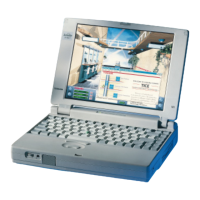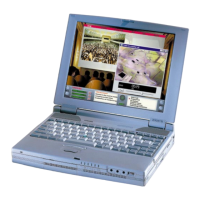
Do you have a question about the Toshiba Satellite 200 Series and is the answer not in the manual?
| Optical Drive | CD-ROM or DVD-ROM |
|---|---|
| Operating System | Windows 95 or Windows 98 |
| Battery Life | Up to 2.5 hours |
| CPU | Intel Pentium or Celeron |
| RAM | 32MB |
| Display | 12.1" TFT LCD |
| Ports | USB, VGA, serial, parallel, infrared |
| Audio | Stereo speakers, microphone |
| Network | 56k modem, Ethernet |
Ensures all necessary components are received before setup.
Provides guidelines for correct seating and posture for maximum computing comfort.
Provides instructions on connecting the computer to a power source and charging the battery.
Explains the benefits of adding memory and how it can improve computer performance.
Provides step-by-step instructions for installing a memory module into the computer.
Provides steps for powering on the computer for the first time.
Introduces the Windows 95 desktop and its key features like the Start button and taskbar.
Teaches basic operations of the AccuPoint for cursor movement and selection.
Explains how to create folders to organize documents and other files.
Guides on creating shortcuts on the desktop for quick program access.
Explains the critical process of saving documents to prevent data loss.
Explains how Windows 95 automatically detects and sets up PC cards, or uses the Card Wizard.
Provides step-by-step instructions for installing a PC Card modem into the computer.
Guides on configuring the computer's Internet connection, including modem setup.
Guides on installing and configuring a serial mouse within Windows 95.
Introduces password protection for keeping computer files and system secure.
Guides on creating a user-level password through Hardware Setup.
Details the power-on password feature that requires entry upon system startup.
Guides on using Device Manager to configure system components and resolve hardware conflicts.
Guides on identifying and resolving hardware conflicts using Windows Help.
Explains how to set or reset user-level system passwords using TSETUP.
Guides on how to start the diagnostic test program by booting into MS-DOS mode.












